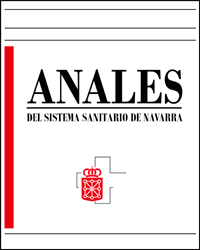Eosinophils in induced sputum versus nitric oxide in exhaled air: clinical utility in bronchial asthma
DOI:
https://doi.org/10.23938/ASSN.0160Keywords:
Asma. Esputo inducido. Eosinófilos. Óxido nítrico. Agonistas osmóticos.Abstract
Background. Assessment of eosinophils in induced sputum can help to optimize anti-inflammatory therapy in bronchial asthma, but this is a very demanding technique. The aim of the study is to compare nitric oxide in exhaled air (FeNO), an easy to measure inflammatory biomarker, with eosinophils in sputum in terms of relationship with clinical and functional parameters. Methods. 106 asthmatic patients (50 in anti-inflammatory therapy [AB+] and 56 without it [AB-]) and 15 controls were included. After filling a clinical questionnaire, FeNO measurement, forced spirometry and sputum induction by bronchial challenge with hypertonic saline solution were performed. Results. Adequate measurements of FeNO and eosinophils were obtained in 100% and 81% of the patients, respectively. FENO w were higher for AB- compared to AB+ and controls. The percentage of eosinophils in sputum was higher in asthmatic patients compared to controls but without differences between both asthmatics groups and was well correlated with the slope of the dose-response curve of bronchial challenge. In the AB- group, FeNO and eosinophils were well correlated with asthma control level. Conclusion. FENO measurement is readily available and well correlated with clinical and functional markers asthma expression. Anti-inflammatory therapy blunts FeNO levels compromising its utility in the long-term follow-up of asthma patients.Downloads
Downloads
Published
How to Cite
Issue
Section
License
La revista Anales del Sistema Sanitario de Navarra es publicada por el Departamento de Salud del Gobierno de Navarra (España), quien conserva los derechos patrimoniales (copyright ) sobre el artículo publicado y favorece y permite la difusión del mismo bajo licencia Creative Commons Reconocimiento-CompartirIgual 4.0 Internacional (CC BY-SA 4.0). Esta licencia permite copiar, usar, difundir, transmitir y exponer públicamente el artículo, siempre que siempre que se cite la autoría y la publicación inicial en Anales del Sistema Sanitario de Navarra, y se distinga la existencia de esta licencia de uso.








